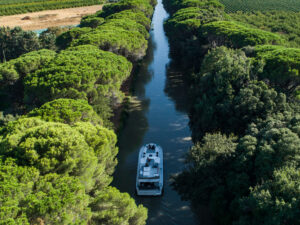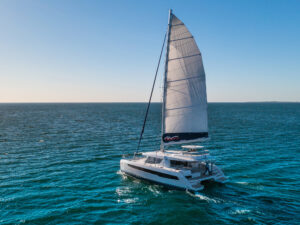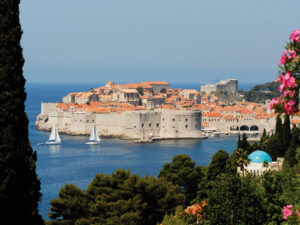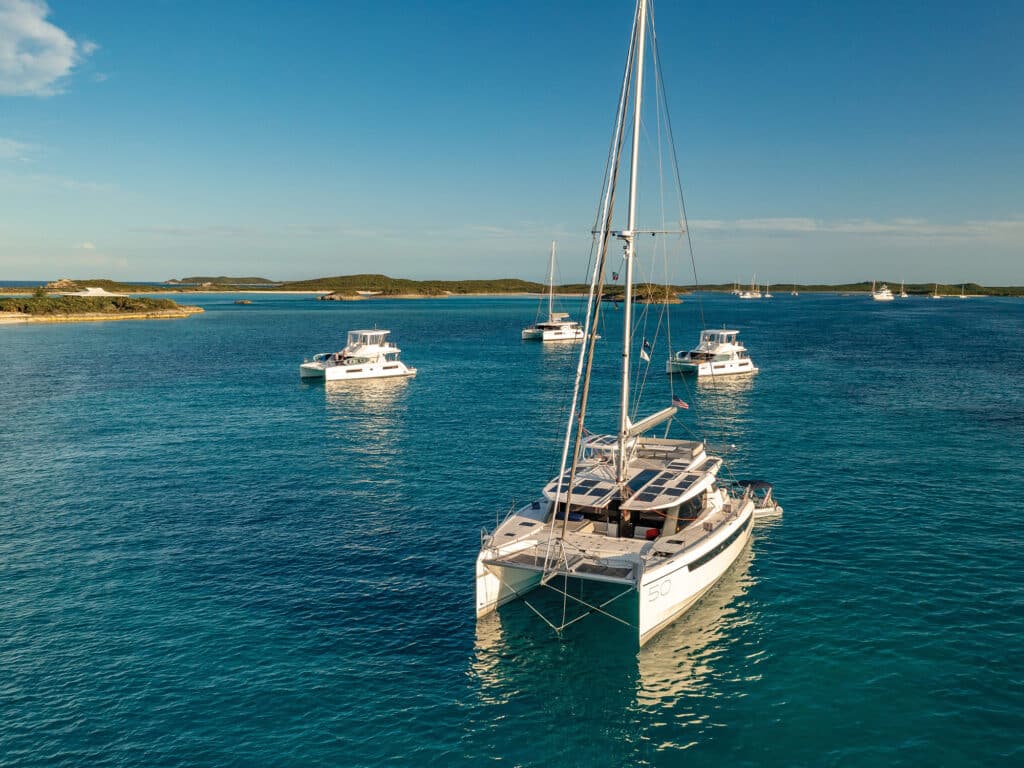
For some reason, flotilla charters seem to have a stigma attached to them, especially among experienced bareboat charter skippers.
“I don’t want to be led through the islands like a string of rubber duckies,” one sailor says. Another says: “I want the freedom to run my own boat, sleep late when I want, and stop for a snorkel.” Yet another: “Flotilla charters are just for beginners, and I don’t want to be slowed down.”
Those are three common misunderstandings that have kept flotilla charters from being as popular with North American charterers as they are with Europeans, who embrace flotillas as a great vacation choice.
The very word, flotilla, seems vaguely military and suggests a group of boats being herded along by a mothership. Nothing could be further from the truth. In fact, many companies now label flotillas as “social charters” because it’s a more accurate description.
Social chartering in Europe is just as popular with experienced charterers as it is with first-timers. In fact, many charterers with years of bareboating return from their first social charter asking, “Why didn’t we do this earlier?”
Here’s how a social charter works: A charter company puts together a package for a particular destination, such as the British Virgin Islands, for a dozen or so boats. An itinerary is laid out to include the most interesting stops, where special events are planned.
All well and good, but it’s here that experienced sailors start getting antsy, because cruising along with most flotillas is a team (on their own boat) from the charter company, including a captain, engineer and host/hostess. Often called the “lead crew,” this threesome is one of the elements that makes social chartering so special.
The captain is a local who provides a briefing for the skippers every morning, going over the charts and discussing a general plan for the day. The engineer or service tech is there to make sure that everything works perfectly. And the host/hostess? They are there to take care of special events and help with individual plans.
The captain’s briefing each morning sets out the general plan for the day, but one of the best parts is the discussion of all the attractions along the way: a great lunch cove, a reef for snorkeling, or perhaps a perfect beach. The itinerary is flexible and you’re free to move as you please, but with the reassurance of having the lead crew nearby.
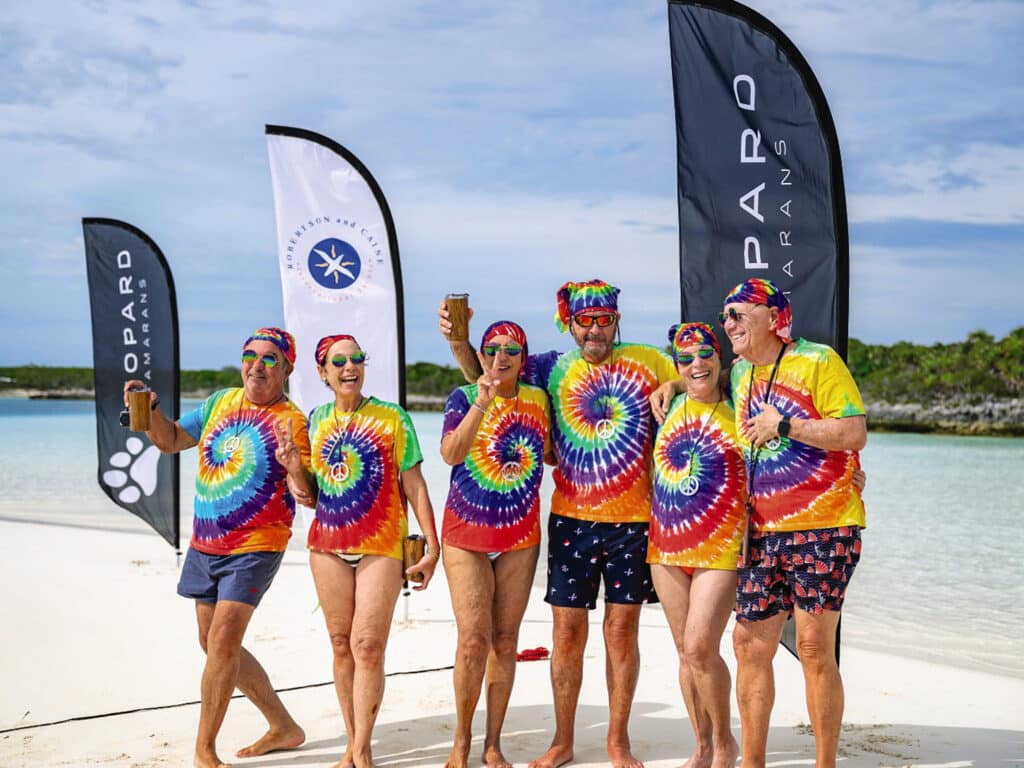
Do you have to sail along with the other boats? Of course not. Each skipper plans the adventures for the day, depending on the crew’s preferences.
When you arrive at the day’s destination, the lead crew will lend a hand with your anchoring (at your request) but, once settled, you’re on your own. Barbecue on board, visit a local restaurant (with reservations made by the host/hostess) or simply enjoy sundowners in your own cockpit.
It’s called social chartering for a reason. You’ll meet and mingle with other crews who all share one thing: They love bareboating. Friendships have been made during social charters that last for years, and that have led to future social charters together. I know of one marriage that resulted from college kids who met during their parents’ social charter.
Part of the fun of social chartering is meeting up with everyone at your destination for dinners, beach picnics, or a progressive party with munchies on one boat and everything from salad to dessert on others.
But, you ask, won’t we miss out on some destinations with a social charter? Not likely. In fact, because the lead crew is intimately familiar with this area, you’ll probably get more out of a social charter than if you were doing it on your own without their local knowledge.
Some flotilla charters are more choreographed but to your advantage. The Moorings, for example, offers several Italian Cuisine Flotillas to explore the food and wine of the Amalfi Coast. Kicked off with a pizza party, the fleet harbor-hops with dinners—from apéritif to tiramisu—ashore in the evenings. The flotilla also provides transfers to restaurants and wineries, and a cook aboard one day to teach boaters how to prep an Italian meal.
Social charters are perfect for kids too. They meet other youngsters to share their explorations. Some charter companies, such as Sunsail, often include a kids’ activity coordinator on social charters during school holidays. This youth leader takes the youngsters off on adventures so that the parents can have some time for themselves. Whether it’s hunting pirate treasure on an island to staging a kids-only barbecue onshore, this service is a part of a social charter.
For first-time charterers, social charters are a great way to hone basic boating skills. The lead crew is always available to help with anchoring and departures, as well as to provide support and local knowledge along the way. Freshwater pump acting up? It’s fixed in a jiffy from the spare parts and tools the lead crew has.
For experienced skippers dipping their toes into a new charter destination, a social charter provides the benefit of local knowledge. No matter how much you’ve planned or how many cruising guides you’ve studied, nothing gives you more confidence than going over a chart with someone discussing their home waters.
Social charters really are the perfect recipe for fun: a blend of independent bareboating with an unobtrusive support team. You enjoy the privacy of your own boat but benefit from a wealth of local knowledge provided by the lead crew.
Social chartering: It’s the best of bareboating.
Chris Caswell is the editor of CharterSavvy, the free online magazine devoted to bareboat chartering.

